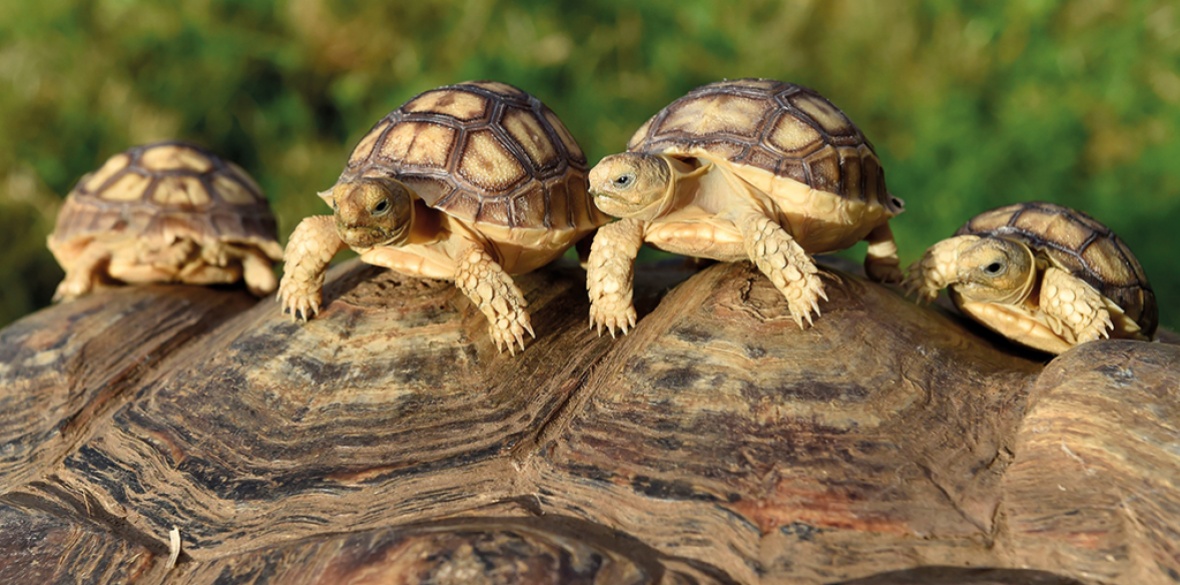This is the last article you can read this month
You can read more article this month
You can read more articles this month
Sorry your limit is up for this month
Reset on:
Please help support the Morning Star by subscribing here
I’VE always been fascinated by Chelonia. That’s the scientific name for turtles, tortoises and terrapins — hard-shelled, egg-laying reptiles.
As a small child I was taken to London Zoo to ride on the back of a huge Galapagos tortoise. My great hero Charles Darwin first brought several giant Galapagos tortoises back to London after his epic voyage on HMS Beagle.
Some lived over 170 years in captivity. Darwin discovered each island had a slightly different tortoise species, another proof of evolution.
As a child I had a number of tortoises as pets. They were very cheap to buy, and cheap to feed, eating cabbage and lettuce trimmings and other similar kitchen scraps. They arrived as ballast on ships from Greece.
The catch came in winter. It took real skill and knowledge to deal with an animal that wanted to hibernate. Most went to sleep and never woke up.
I’m embarrassed to say the normal solution was to buy another tortoise in the spring. Sadly we neither knew nor cared too much about depleting wild populations.
Tortoises are still imported despite the fact that it is illegal to own them unless they are captive bred or old enough to have been born before the regulations changed.
If you think that excuse about being older than the law is a bit far-fetched meet Zuma — short for Montezuma, a male spurred tortoise.
He has belonged to Sarah Joiner for over 40 years and is approaching his 100th birthday — sadly tortoises don’t get a telegram from the Queen.
When Zuma discovered a rubbish bag full of delicious lettuce leaves he crawled in for a feast. Once Zuma had eaten he settled down to a postprandial nap. As he slept his black plastic sleeping bag was sealed and dumped with many other identical bags waiting collection.
Joiner was distraught. She phoned the council and they started an amazing rescue. First the black bag was traced to the depot using GPS. Refuse workers spent hours searching through thousands of identical bags using a thermal imaging camera.
Eventually they found Zuma. He was not much harmed by his adventure and is back living at home with owner Sarah who praised the amazing teamwork that brought Zuma back home.
Our only true native Chelonia are sea turtles. They are probably more common than you would think but generally only skilled divers see them.
Exceptionally one is washed ashore dead. A week before Christmas last year a quarter of a ton (250kg) 1.7m (5ft 7in) long leatherback turtle was washed up in Mundon Creek, off the River Blackwater in Essex. A first for the East Coast, the corpse was taken to the Natural History Museum in London for examination and preservation.
Leatherback turtles are more common around the Cornish coast where the waters are warmer and deeper. They are the largest turtle species, indeed the fourth largest of all reptiles. Only three species of very rare crocodiles are bigger. Fully grown adult leatherbacks can weigh up to 750kg (17 cwt) and be 1.8m (6ft) long.
At the other end of the Chelonia scale are tiny terrapins, voracious eaters of fish, amphibians, and even ducklings they now inhabit our rivers, park lakes and especially canals.
Experts now worry that terrapins may have bred in Britain for the first time due to the recent hot summer. We know they mate and lay eggs here but so far our summers have not been hot enough for eggs to hatch.
These red-eared terrapins have been living here wild since the Teenage Mutant Ninja Turtle craze in the 1990s. Bought as pets they were dumped in ponds and rivers when they grew too big.
Experts believed that eggs needed a temperature of 30°C for 60 days to hatch but rare sightings of newborn terrapins seem to suggest otherwise.
Additionally we know businesses often pump warm water into canals creating warm micro habitats.
The red-eared terrapin is a native of the US, Mexico and South America. They grow to about 30cm (1ft) across and often carry the disease salmonella. It is illegal to release them into the wild.
My grandson Jamie had a word with me the other day. After many lockdown disappointments he and some mates are finally going to get away on a holiday to the Ionian Greek islands.
He is going to Zakynthos, now better known Zante. I have visited this beautiful holiday island on a couple of occasions.
Zante offers all the usual attractions bars, restaurants and clubs as well as great beaches with water sports and boat trips to remote coves. Add swimming in warm azure waters and you can understand the attraction.
What Jamie wanted to talk to me about was that after he had booked he had heard that the island also had several beaches that were the nesting sites of the endangered loggerhead turtles.
Today there are just six turtle nesting beaches where, from April to June, turtles that were born here return after 20 to 30 years to mate, dig holes in the soft sand and lay their eggs. These hatch after about 60 days, coinciding with the peak holiday season.
In Zante turtles have become a contentious issue. Some locals are keen to cash in and develop the beaches whatever that does to the turtle nesting sites.
Other islanders are doing what they can to protect these rare animals and are marking and protecting the special beach sites where turtles have hatched their eggs for aeons.
Some success has been achieved by conservationists, with visitors banned on the most important nesting beaches and patrols of nest sites.
Even with only natural hazards only one in a thousand newly hatched turtles will reach adulthood. Scrabbling to the sea under the protection of darkness the lights and loud music from beach-front clubs and bars make the tiny turtle’s battle for survival even harder.
I’m sure Jamie and his mates will enjoy their first Greek island and I’m sure they’ll all come back with a better knowledge of some of the difficult issues involved in conservation today.
I hope Jamie doesn’t feel too guilty about the loggerhead turtle. Attitudes change. We all have to learn as we go along, even my hero Darwin while aboard the Beagle didn’t just study the giant Galapagos tortoises — he ate them.
The 300kg (6cwt) tortoises were used by sailors as ballast and also as a live source of fresh delicious meat. Darwin often ate them and loved the buttery taste.
Attitudes to eating giant tortoises have changed just as attitudes to holiday makers and turtles sharing Greek beaches will change too. In the meantime Jamie, have a great holiday.










